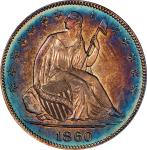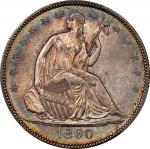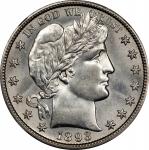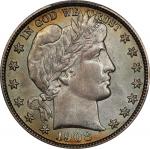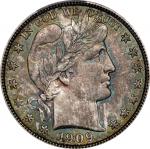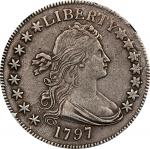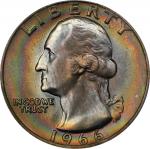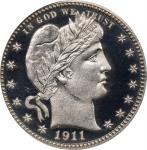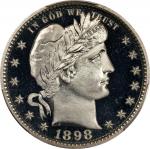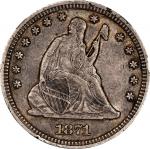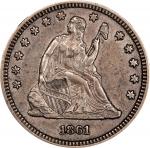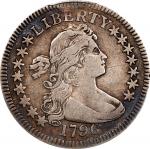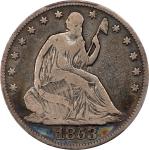1853-O Liberty Seated Half Dollar. No Arrows or Rays. WB-NC-1. Rarity-7+. Fine-12 (PCGS).The famous 1853-O No Arrows half dollar, one of the rarest and most desirable of all Liberty Seated coins. Both sides exhibit moderate, yet even wear with all major design elements boldly outlined, the rims distinct from the peripheral features. Light golden and lilac toning over desirable silver-gray surfaces. Notably, this 1853-O was the next-to-last coin acquired by Louis E. Eliasberg, Sr. to complete his collection (the last being the 1873-CC No Arrows dime).
How did the 1853-O No Arrows half dollar issue come about, and why it is so rare? The Philadelphia Mint shipped new dies to the New Orleans Mint in late 1852, as was common practice, so that new coinage could begin in January. Shipping took time, as this era did not have efficient railroads and the safest route was by sea, which required several days passage from the East Coast to the Port of New Orleans. Research by Richard Kelly and Nancy Oliver, published in their March 26, 2011, <em>Coin World</em> article titled "Curious Origin for 1853-O Without Arrows and Rays Halves," recounts an article that appeared in <em>The Daily Picayune</em>, a newspaper published by the New Orleans offices of the <em>Times-Picayune</em>. Dated January 2, 1853, the article states:
<em>The officers of the Mint in our city marked the opening of the New Year by very appropriately making a new issue of American coin. How extensive that was we are unable to say, but the twenty dollar gold piece and silver half dollar laid on our table for examination, as the product of the massive stamping machinery on the first day of the year, 1853, were admirable specimens of elegant design and finish.</em>
<em></em>This article would seem to account for the earliest appearance of this rare issue for, with the date of striking given as January 1, 1853, the half dollars produced on that day were almost certainly examples of the 1853-O No Arrows. Recall that during this period the California Gold Rush was well under way, with gold pouring out of the fields, streams and valleys into boats for passage to the Philadelphia Mint and Eastern banks, the entire affair disrupting gold prices relative to silver. This caused the price ratio of gold to silver to drop on the gold side, making silver more valuable than before. After 1850, it cost more than face value to strike silver coins. Accordingly, those that were made went into the hands of speculators and melters with yearly mintages dropping accordingly. By early 1853, it cost 53 cents in silver to coin a half dollar, and scarcely any were seen in circulation. In fact, most examples struck from 1850 through early 1853 were lost through melting, and survival rates are only a fraction of the mintages.
Congress, ever ready to pass laws after dutiful and thoughtful examination, finally addressed this crisis with the Mint Act of February 21, 1853, to be adopted on April 1 of that year. This Act reduced the amount of silver required for all coinage except the silver dollar, which for traditions sake was left at the earlier standard. The half dollar was reduced in weight from 208 grains to 192 grains (13.36 grams to 12.44 grams), a reduction of about 7%. This reduction would bring the silver value of a half dollar slightly below face value, thereby stopping further melting of new coins issued after adoption of this Act. The Philadelphia Mint determined to identify this revised silver standard by placing arrows at the date of all silver coinage (other than the silver three-cent piece, which was already only 75% pure silver in content and could not be melted profitably). The newly authorized quarters and half dollars of 1853 were further distinguished by the addition of a glory of rays on the reverse around the eagle. The Arrows and Rays type would stand to "announce" to the general public that these coins were struck to the new reduced weight standard for silver coins, thus they should not be melted as no profit could be made from this venture. As silver coins were in strong demand across the nation, the new dies were prepared and shipped to the branch mints where coinage began in earnest on April 1 to the new standard. It would seem logical that older, heavier (and, hence, more valuable) silver coins struck before this revised standard would be gathered up and melted, including by the Treasury Department, to be coined again at the new lower weight standard. Today it seems hard to imagine that speculators would have so efficiently gathered up millions upon millions of silver coins and had them all melted for the modest spread, given the cost of transport, smelting costs and general risks of such an endeavor in a wildly fluctuating metals market. Regardless of who actually melted most of the old tenor silver coins, one fact is clear, not many of those earlier dated pieces exist today, especially those struck in 1850, 1851, 1852 and early 1853.
Given that the Arrows and Rays coinage was not authorized until February 21, the half dollars struck in the New Orleans Mint and referred to as "the product of the massive stamping machinery on the first day of the year, 1853," in the aforementioned article in <em>The Daily Picayune </em>could only have been No Arrows examples produced to the old weight standard. Unfortunately the mintage of this issue was not recorded, and we also do not know if additional examples were struck between January 1 and the introduction of the new weight standard and associated Arrows and Rays design. It was common practice to use old dies for coinage until they broke or were otherwise no longer serviceable. Indeed, continuing the use of serviceable dies on hand in one year for coinage of the next year was actually standard mint practice. Research by Liberty Seated half dollar experts Bill Bugert and Randy Wiley shows that the reverse of the 1853-O No Arrows is the same as that used to strike 1852-O coins from the WB-2 die marriage. It is most readily identifiable by a faint die line from the eagles right leg to the underside of the right wing. Research by Walter Breen shows that 19 reverse dies were on hand in the New Orleans Mint in 1851, with production somewhat limited by the aforementioned rise in silver price, and by 1852 these dies were not being used as rapidly due to the resultant decrease in production. There were certainly several potential reverse dies available by the end of 1852, and with the new obverse dies arriving at that time, coinage could have begun on January 1 of the following year, as normal for the period, and it obviously did so.
The absence of a mintage figure for the 1853-O No Arrows in federal archives is also not without precedent in U.S. coinage history. Several issues are known to have been struck, the number of examples coined lost to history. The 1824 Capped Bust dime is a case in point, all examples of which were apparently struck and released in 1825 with coins of that date. The fact that New Orleans Mint personnel did not report the mintage of 1853-O No Arrows half dollars is likely because the Act of February 21, 1853 made those coins obsolete.
Estimates on the number of 1853-O No Arrows half dollars struck vary from several hundred to several thousand pieces, certainly no more than 3,000 to 4,000 coins. Regardless of how many examples were actually produced, virtually all were destroyed through melting, particularly after the Act of February 21, 1853 replaced these coins with their lighter-weight Arrows and Rays counterparts. Today, only four examples of this rare and enigmatic issue are positively confirmed to exist, the first of which was announced by John W. Haseltine circa 1881. The most recently discovered specimen made its numismatic auction debut in our Philadelphia ANA Rarities Night Auction of August 2012. The four confirmed examples are as follows:
1 - <strong>PCGS VF-35</strong><strong>.</strong> Ex John W. Haseltine, circa 1881; W. Elliott Woodwards sale of the J. Colvin Randall Collection, June 1885, lot 421; Harold P. Newlin; T. Harrison Garrett, to Robert and John Work Garrett, by descent, 1888; Robert Garrett interest to John Work Garrett, 1919; transfer completed 1921; John Work Garrett to The Johns Hopkins University, by gift, 1942; our (Bowers and Ruddys) sale of the Garrett Collection for The Johns Hopkins University, Part I, November 1979, lot 339; David Queller; our (Stacks) sale of the Queller Family Collection of U.S. Half Dollars, October 2002, lot 530; our (Bowers and Merenas) sale of Jim Grays North Carolina Collection, July 2004, lot 2332; our (Stacks) sale of the George "Buddy" Byers Collection, October 2006, lot 1160; our ANA Auction of August 2017, lot 2099.
2 - <strong>PCGS Fine-12.</strong> Ex B. Max Mehl, discovered in a California collection, 1938; Charles M. Williams; Numismatic Gallery; Numismatic Gallerys Adolphe Menjou Sale, June 1950, lot 1084; Louis E. Eliasberg, Sr.; our (Bowers and Merenas) sale of the Louis E. Eliasberg, Sr. Collection, April 1997, lot 1955. <em><strong>The present example</strong></em>.
This provenance is confirmed by a document seen in Louis E. Eliasberg, Sr.s personal files. In a letter written to Mr. Eliasberg in 1949, renowned Fort Worth dealer B. Max Mehl stated, "The Williams [sic] specimen I discovered in California a number of years ago and I sold it to Mr. Williams of Cincinnati." Additional commentary from Mehl made at the time he offered this coin for sale in 1938, and as quoted in our (Bowers and Merenas) April 1997 Eliasberg Collection catalog, p. 229, provides further details:
<em>A few months ago I was contacted by a collector on the Pacific Coast who claimed to possess one of these great rarities. But after long experience, I never get excited about things of this sort without seeing the coin. The coin was finally sent to me for my inspection and, lo and behold! To my great and pleasant surprise I found the coin to be an absolutely genuine specimen of this great rarity.</em>
On the other hand, most modern numismatic references and auction catalogs give this coins earliest provenance as some variation of:
<em>Ex Chicago trolley car conductor, circa 1909; his supervisor; Stevens and Co. (Chicago); Charles Wilcox (Chicago); DeWitt Smith; H.O. Granberg, exhibited at the 1911 ANA Convention and 1914 ANS Exhibition; William H. Woodin; Waldo C. Newcomer; B. Max Mehl; "Colonel" E.H.R. Green; Charles M. Williams.</em>
Unfortunately, each early aspect of this provenance chain is either incorrectly assigned to the Eliasberg specimen, or completely inaccurate. Regarding the former, the coin in the Newcomer plates is the Colin E. King specimen (#4 below) and, additionally, Eric P. Newmans notes on the "Colonel" Green estate report only a single 1853-O No Arrows half dollar therein, which is also the King specimen. The June 1894 issue of <em>The Numismatist </em>reported that DeWitt Smith already owned an 1853-O No Arrows half dollar at that time, which could only have come from S.H. and H. Chapmans sale of the Colin E. King Collection in 1892. Furthermore, since DeWitt Smith died in 1908, it makes no sense that he would have acquired the alleged Chicago trolley coin specimen discovered circa 1909. The King specimen did, however, pass from DeWitt Smith to H.O. Granberg, as noted in the foregoing provenance chain. We have added all of these previous owners - Smith, Granberg and Newcomer - to the provenance chain of the King specimen listed below, finally correcting these errors in the modern numismatic literature.
Regarding Charles Wilcox, Saul Teichman has confirmed that when Wilcox sold his collection in 1901, it did not contain an 1853-O No Arrows half dollar, suggesting that he never owned one. Likewise, William H. Woodin does not appear to have owned the King specimen in between Granberg and Newcomer, his name inserted into the provenance chain by Walter Breen erroneously and without substantiation.
This leaves the earliest part of this provenance chain unresolved. It is based on the September 3, 1911 issue of the <em>Philadelphia Inquirer</em>, which states:
<em>An 1853 half dollar, which was taken by a conductor on a Cottage Grove avenue car a few years ago, is said by numismatists of the American Numismatic Association exhibit at the Art Institute, to be the most valuable coin in the exhibit.</em>
<em>The conductor turned the half dollar in at the barn. The barn man replaced it by another and sold it to Stevens & Co., of Chicago, for $5 who sold it to Chas. Wilcox of Chicago for $100. Wilcox in turn sold it to DeWitt Smith, of Lee, Mass., for $500. Smith later refused to sell it for $2,500.</em>
<em>It is now on exhibit in the collection of H.O. Granberg, a wealthy mine owner of Oshkosh, Wis., and though Mr. Granberg will not say what he paid for the coin, it is safe to say that it was far more than Smith refused. The coin lacks the arrows and suns rays which appear on all other coins of the same mintage.</em>
Now that it has been proved that the DeWitt Smith-H.O. Granberg coin came out of the 1892 sale of the Colin E. King Collection, and also that Charles Wilcox likely never owned an 1853-O No Arrows half dollar, this account can be safely dismissed. Either the alleged Chicago trolley car specimen turned out to be a counterfeit or altered coin or, more likely, the story was simply fabricated at the time of the 1911 ANA Convention to promote the display of the King-Smith-Granberg coin at that event.
- <strong>PCGS VG-8.</strong> Ex Howell Family estate; our Philadelphia ANA Auction of August 2012, lot 11447; Heritages ANA Signature Auction of August 2015, lot 4060; Heritages sale of the Poulos Family Collection, Part II, September 2019 Long Beach Signature Auction, lot 4756.
This is the first 1853-O No Arrows half dollar discovered since the early 20th century, and it was nearly lost to the numismatic community. This half dollar was long held in a Northwestern family as part of a group of silver coins stored in a suitcase in the basement. When the wife of the original owner passed away, the coins were discovered and examined by the heirs, one person noticing an odd, old half dollar of 1853 and looked it up in a coin reference, where it was noted to be a "no arrows or rays" piece. The coin was taken to a local coin shop along with the additional silver coins and nearly sold for $15 with the balance of the holding. Numismatically insignificant bulk silver coin purchases are usually directed to one of the various smelters and sold for scrap silver value, then melted and turned into silver bars. The heirs wisely decided to keep this one particular coin, however, and after further examination made the fortuitous decision to contact Stacks Bowers Galleries, where we were given the opportunity to examine photos of the coin. The coin did not appear to be altered or even counterfeit as so commonly seen on such new discoveries, and we requested and received the opportunity to examine the coin in person. The coin was eventually submitted to PCGS where, after confirming the diagnostics and weight, it was indeed determined to be a new discovery and the fourth known 1853-O No Arrows half dollar.
4 - <strong>PCGS Good-6. CAC.</strong> Ex S.H. and H. Chapmans sale of the Colin E. King Collection, April 1892, lot 854; DeWitt Smith; H.O. Granberg, exhibited at the 1911 ANA Convention and 1914 ANS Exhibition; Waldo C. Newcomer; "Colonel" E.H.R. Green; our (Stacks) Anderson-Dupont Sale, November 1954, lot 2143; Charles A. Cass; our (Stacks) Empire Sale (Cass), November 1957, lot 1394; A.M. and Paul Kagin (Hollinbeck Coin Company); our (Stacks) R.E. Cox, Jr. Sale, April 1962, lot 1928; our (Stacks) E. Yale Clarke Sale, October 1975, lot 289; Julian Leidman; NASCAs Matthew Bryan Collection sale, November 1977, lot 742; Herbert I. Melnick, Inc.s Leon Goodman Collection sale, July 1982, lot 1712; Julian Leidman; Jules Reiver; Julian Leidman; Jonathan Kern; Charles Barasch; New York collection; Charles Barasch; Julian Leidman; Kenneth Goldman; South Florida Rare Coins; our sale of The 1853 Collection, October 2014, lot 10026.
Obviously one of the most significant offerings in this sale, the opportunity to acquire the Eliasberg specimen of the 1853-O No Arrows half dollar - second finest of only four known - deserves the attention of advanced collectors specializing in Liberty Seated coinage, the New Orleans Mint, or the connoisseur with a taste for numismatic rarities. We anticipate keen bidder interest and fierce competition when this coin comes up for auction.
This lot includes a custom large blue Capital Plastics holder created for this coin as part of the Eliasberg Collection. <em><strong>The holder is available to the winning bidder upon request to Stacks Bowers Galleries at the close of the auction</strong></em>.
Stacks Bowers Galleries wishes to thank Saul Teichman for this assistance in researching and correcting the provenance chains of the Eliasberg and King specimens of the 1853-O No Arrows half dollar, the revised versions of which are presented for this first time in this catalog description.PCGS# 6270. NGC ID: 27SX.From the Louis E. Eliasberg, Sr. Collection. Earlier ex B. Max Mehl, discovered in a California collection, 1938; Charles M. Williams; Numismatic Gallery; Numismatic Gallerys Adolphe Menjou Sale, June 1950, lot 1084; Louis E. Eliasberg, Sr.; our (Bowers and Merenas) sale of the Louis E. Eliasberg, Sr. Collection, April 1997, lot 1955.

